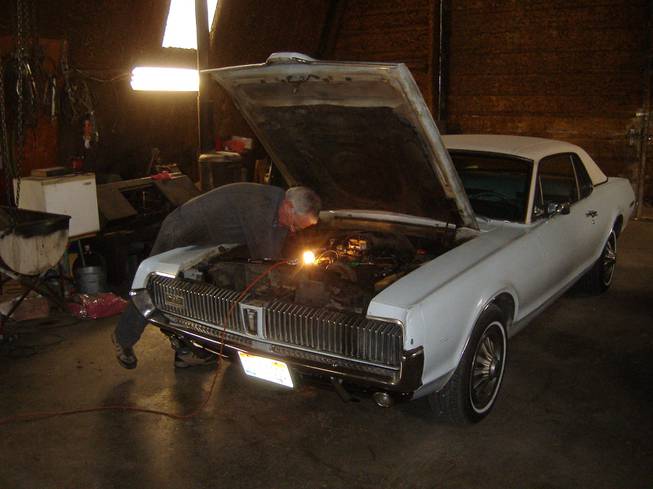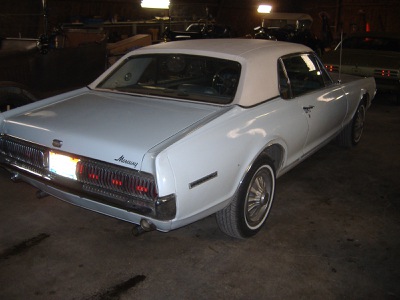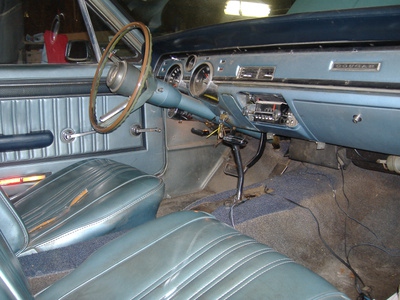
Uncle James Katsilometes opens the patient and gazes inward with the help of an old lamp.
Friday, Dec. 24, 2010 | 10:42 a.m.
The car never had a name. You know how people give their vehicles names -- someone might own a Toyota Prius and name it Lance, for Lance Armstrong, because it so rarely gets gassed. Rusty is an apt name for a rusted-out pickup; I know because there was once an old Ford F-150 in my family, a truck that logged more than 300,000 miles, with just that name.
As we rationalized, naming the vehicle for its cosmetic deficiencies is far cheaper than paying for the expensive bodywork to remove the rust.
But I never gave the 1967 Mercury Cougar Dan Gurney Special any particular name. It came to be known, over the years, as the Super Cougar, for its superhero-like capacity to withstand my neglectful ownership.
For a time, a few friends took to calling it the Cougar Inn. This name evolved because a buddy and I once had slept in the Cougar in a vacant lot across from a convenience store near South Lake Tahoe, the thermostat sliding to below 30 degrees and our breath frosting over the windows.
I’d not thought to check the gas gauge, the needle inching inevitably to “E,” as we started out of town. So we parked. We slept. At dawn, we bundled up, gassed up and roared away.
The whole episode played out like an old Springsteen song.
I bought this car in July 1988, when I lived in Chico, Calif., and I wrote about it then. The joke (among many, over the subsequent years) was that I’d bought a car as old as me. That’s about right; I was a baby when the Mercury Cougar first hit the showrooms. My car search of the summer of 1988 was not particularly thoughtful or well-conceived. I simply test drove every car for sale in rural Northern California, including an old Dodge Dart, a timid little Ford Escort, a muscular 1965 Pontiac GTO (a car that practically screamed “moving violation”), a 1976 Toyota Celica with a metallic-blue paint job and countless other crappy used cars hawked by local dealers and independent sellers.
I test drove a Yugo, too, so one day I might tell friends and family, “I have driven a Yugo.”
I decided on the Cougar through impenetrable logic -- I’d been impressed by the sticker in the rear window bragging that the car was the 1967’s Motor Trend Magazine Car of the Year. The decal bore the signature of Dan Gurney, who I knew was some sort of racing star. And I’d heard of Motor Trend, too, which I understood to be a publication focusing on trends in motorized vehicles.
The car was stout and strong, the driver encased in a metal fortress. You could hang a magnet just about anywhere in, or on, the ’67 Cougar.
How could I go wrong? The woman who sold me the Cougar was the daughter of the original owner, the car’s odometer read just a little more than 89,000 original miles. It was never the family’s primary vehicle, purchased largely because someday the car would fetch a hefty sum as a result of the priceless endorsement of Dan Gurney. Other Dan Gurney Special features included whitewall tires, fancy hubcaps and a chrome engine “dress-up” kit, with a chrome air cleaner, chrome radiator cap and even a chrome dipstick. Yes, someone in the Ford/Mercury marketing division arrived at the idea of a chrome dipstick for this car, which would impress anyone changing the oil -- and no one else.
It had an AM radio, too. No FM. As I said at the time, I like the radio because it plays old music.
The car was powered by a quick, and sufficiently loud, 289 V-8 engine. The Cougar was sentimentally relevant, too, because of what was sold to finance its cash payment. During my teenage years, I’d owned two antique Fords given to me by my grandfather, a grand Greek gent we called Populi.
One of these fantastic cars was a deep green 1929 Model A Sedan Delivery. The other was a crimson 1933 Model A Ford pickup.
Between ages 16 and 21, these were my rides. For reasons that even today seem unacceptable (I was equal parts broke and short-sighted), I sold those cars. The cash left over from those transactions -- only a percentage, not close to the entire take -- went to this ’67 Cougar. For the past two decades, it has represented my last tangible connection to Populi’s vintage auto collection.
And for the five years I drove the Cougar as my primary car, I treated it like the proverbial rented mule, if you were to never take the mule to the vet.
The first time I’d ever surpassed 100 mph was in the Cougar, during a late-night dash from Redding (where I moved, with the car, three years after buying it) to Chico. It made countless trips from Chico and Redding and back. From Chico to the Bay Area. From Chico or Redding to Reno or Tahoe. Across Nevada to Pocatello, Idaho.
When it needed new tires, instead I drove to Idaho. An oil change? Of course -- but first, let’s drive to Reno!
One time I was driving through the frontage roads that cut across the orchard farms and rice paddies of Northern California, and something about the size of a rugby ball and heavily feathered crashed into the windshield. Blood splashed across the window, the antenna snapped free, and I broke hard to the side of the road.
It was a pheasant. My next stop was to a service station to clean up the mess. As I pulled up, a fellow motorist gazed at the blood-and-feather carnage across the front of the Cougar, his face frozen in abject shock.
“Pheasant,” I said. “Good eatin’, too.”
While on my way to cover a high school basketball game in Mount Shasta City, Calif., I lost control of the Cougar in a driving winter storm (all-weather tires having never been part of the car’s story) and slid helplessly into a show drift. I backed ’er out and was still able to make the game on time.
But this sort of treatment could not last forever.
If there were such a condition as vehicle abuse, the Cougar certainly suffered from it. The car finally just gave out in the winter of 1993, faltering from assorted cosmetic and mechanical maladies. Maybe the absence of a rightful oil change or tune-up for the previous five years had something to do with it. But after a trek from Redding to Red Bluff and back, covering the Red Bluff Holiday Classic Basketball Tournament, I bought an upgraded 1985 Cougar, rented a storage shed and parked the ’67 in climate-controlled darkness.
For 17 years.
It was only recently that I related the legend of the Cougar to a family member, my cousin Athan, who has the inclination and mechanical skills to actually work on cars. Athan lives in Houston and is the son of my Uncle James Katsilometes, who, in a curious twist of fate and employment, was once the property manager for Jim Rogers’ estate and car collection when most of that collection was stored in Pocatello.
The Rogers-Katsilometes vehicle connection is strong -- most of Populi’s vintage auto parts and even some of the family’s restored cars have been sold to Rogers, and his collection is now intact across the road from KSNV Channel 3’s offices on Foremaster Road.
A 1967 Cougar in action, Part 1
A 1967 Cougar in action, Part 2
My cousin Tom’s old 1949 Mercury Woody Wagon now belongs to Rogers, for instance, and I am one person who can honestly ask the Sunbelt Communications founder, “How’s the Woody?” and not be hustled off by security.
From time to time, Athan -- blessed with an untrammeled fondness for vintage American-manufactured vehicles -- would ask me about the Cougar. “Still in Redding,” I would say, “collecting dust and memories.”
He persisted, persuasively arguing that it would be fun to drag the Cougar to daylight, stop paying storage fees and return the great car to the streets.
Over the summer, Athan asked once more about the car. “What’s up with the Coug?” he inquired, as if the vehicle somehow pulled a Chitty Chitty Bang Bang and soared, in happy song, to freedom. He finally offered to buy the car, and I relented.
But I would not take money for the Cougar -- bad karma.
“Take it, Athan,” I said, laughing in disbelief at his persistence. “Spin your magic.”
Within two weeks, the car was hauled from Redding to Populi’s old work shed in Pocatello, where Uncle James (Dr. Uncle James, in this context) volunteered his time in retirement to operate on this comatose patient. Instead of bloody surgical scrubs, he wears an oil-stained blue jumpsuit and grips an old handheld lamp to illuminate the 43-year-old engine. God bless him, too, because the doctor was presented a patient that has suffered as few have.
Upon arrival, the Cougar’s baby blue paint job and white vinyl top was covered with at least two inches of high-grade, storage-unit dust. The hood was askew, from that ramming in Mount Shasta City. The tires, all four, flattened; the front wing window shattered by a foul ball during an American Legion baseball game at Tiger Field. The driver’s side door had long been rendered inoperable. The wadded-up aluminum foil gum wrappers stuffed between the horn and steering wheel? I jammed those in there because the horn was malfunctioning and needed to be supported, somehow; otherwise, it would blare ceaselessly.
The cars’ trunk was filled with artifacts from a different life -- a collection of vinyl albums (including the full catalog of Rush LPs I’d forgotten about), two high school yearbooks, and dozens of double-A batteries I used in microcassette recorders had been tossed into that pile. Also retrieved was jarring evidence of self-destruction: two cans of Bud Dry. Remember Bud Dry? Me, neither. One can was empty, the other full. I cannot explain how I left a can of Bud Dry full in the 1990s -- that was a bigger upset than Buster Douglas knocking out Mike Tyson.
But over the months, Uncle James has returned the Cougar to life. The cosmetic damage has been largely repaired -- the wing window replaced, the driver’s side door fixed after two days of energetic wrenching. The steering wheel and horn have been returned to their intended alignment. The whitewalls are new. The car has been washed and buffed out -- you can still read the Dan Gurney decal in the back -- and the Cougar’s signature sequential taillights and flip-up headlights all work properly.
“The car is all there,” Uncle James told me last week, when I was finally reunited with the Cougar at Populi’s old shop. “There is not a spot of rust on it, anywhere.”
“It was sitting inside a shed for 17 years,” I said, somewhat proudly. “That might be why.”
The car is still being worked over, on the very spot my grandfather assembled the ’29 and ’33 Model A’s. There are three Model T’s in the shed now, and another Model A, a trick little 1931 convertible owned by Uncle James.
After several minutes of looking over the Cougar in stunned silence, I asked my uncle to fire up the V-8. The moment of truth.
“The engine’s a little tired,” he warned, like a physician explaining that a patient returning to consciousness not might remember his own brother.
Then he fired it up, and the engine roared to life.
“Sounds good to me!” I shouted while coughing out exhaust.
Tired? Not really. It sounds strong, resonant. It is a survivor, the Cougar. The car is a Christmas gift, to Athan and even back to Populi. It might be just a hint to all that he gave me, but I can happily report that, today, we are both in good repair.
Follow John Katsilometes on Twitter at twitter.com/JohnnyKats.







Join the Discussion:
Check this out for a full explanation of our conversion to the LiveFyre commenting system and instructions on how to sign up for an account.
Full comments policy